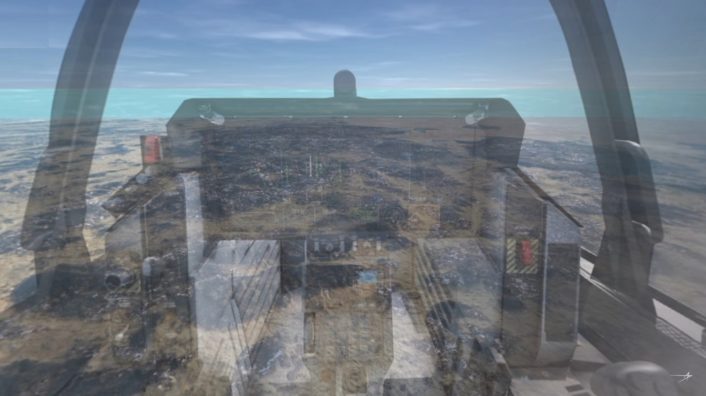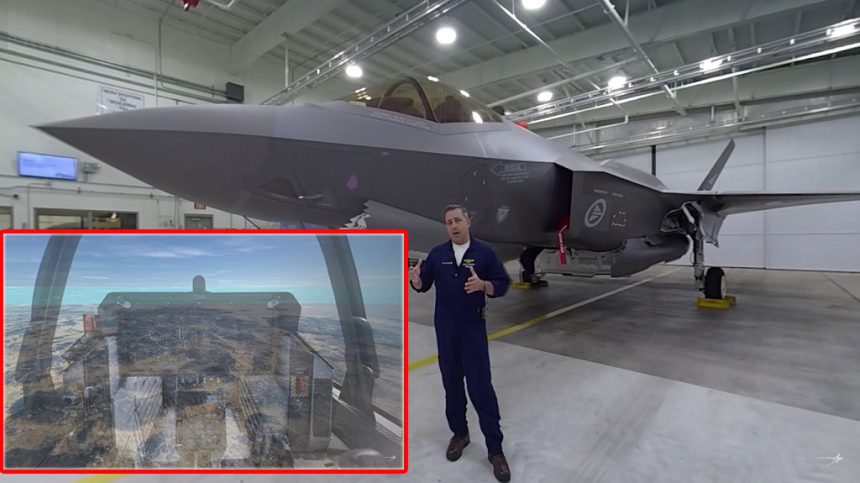Using Augmented Reality, the footage shows how an F-35 pilot can see through the aircraft, along with many other interesting things.
On June 3, 2019, Lockheed Martin published an interesting 360-degree video walkaround of the F-35, hosted by Tony “Brick” Wilson, the test pilot that conducted the first F-35C carrier landing. In this video, recorded around a Royal Norwegian Air Force’s F-35 in Fort Worth, Wilson explains some of the most important systems, adding also some less known insights.
As pointed out in the video, the fifth-generation fighter is defined not only by stealth, but also by sensor fusion and data sharing. Stealth, in turn, is provided by reduced radar detection, infra-red signature masking, visual masking and radio signal reduction.
The first system showed by the test pilot is the EOTS, the most important sensor along with the AN/APG-81 AESA (Active Electronically Scanned Array) radar. EOTS stands for Electro-Optical Targeting System and is composed by two subsystems, TFLIR (Targeting Forward Looking Infra-Red) and DAS (Distributed Aperture System). Interestingly, on Lockheed Martin, Northrop Grumman and official F-35 websites EOTS and DAS are described as separate systems, with TFLIR being one of the cameras used by EOTS (the others are a CCD-TV camera and a laser). This seems to be confirmed also by the systems having two separate official designations, AAQ-40 EOTS and AAQ-37 DAS. Those systems, together with the APG-81 radar, allow the pilot to locate, track and target enemy aircrafts, ground vehicles or any other target in both day and night and in all weather conditions.
EOTS, or TFLIR (Targeting Forward Looking InfraRed) as called in the video, is the equivalent of the traditional targeting pods carried externally by legacy fighters. In this case, the system is developed by Lockheed Martin from the Sniper XR (Extended Range) targeting pod and integrated into the airframe, mounted under the nose as a compact solution that minimizes radar signature, or Radar Cross Section, and aerodynamic drag. The pilot can use it to visually acquire the target and employ weapons autonomously in the Laser Targeting mode or even detect targets lased by other aircrafts or troops on the ground in the Laser Spot Track mode. As stated by Lockheed Martin, the F-35 is scheduled to receive a new version of the EOTS: “Advanced EOTS, an evolutionary electro-optical targeting system, is available for the F-35’s Block 4 development. Designed to replace EOTS, Advanced EOTS incorporates a wide range of enhancements and upgrades, including short-wave infrared, high-definition television, an infrared marker and improved image detector resolution. These enhancements increase F-35 pilots’ recognition and detection ranges, enabling greater overall targeting performance.”
The other and most innovative subsystem is the Distributed Aperture System, a network of six cameras around the aircraft that provide 360 degree field of view to the pilot, giving him also the ability to see through the aircraft structure, thanks to the imagery projected onto the helmet’s visor. The DAS, produced by Northrop Grumman, is designed to operate as Missile Approach Warning Sensor (MAWS), InfraRed Search and Track (IRST) sensor and Navigation Forward-Looking InfraRed (NAVFLIR). Using simpler terms, the system can warn the pilot of incoming aircraft and missile threats, provide day/night vision and additional target designation and fire control capability. During testing the system was able to detect, track and target five ballistic rockets fired in rapid succession and even detect and locate tanks that were firing during a live fire military exercise. Like EOTS, DAS is receiving an upgrade that will further enhance its capabilities.
The helmet, now at his 3rd generation, is an integrated part of the aircraft and an additional sensor for the pilot. The images, generated by two projectors and then displayed on the inner visor, can include DAS imagery, flight critical info (like speed, direction and altitude), tactical info (like targets, friendly aircrafts, navigation waypoints) and night vision. The possibility to use night vision without losing the listed imageries and symbology is one the biggest innovations introduced by this helmet. Until today, as pointed out by Wilson, during night operations US pilots had to choose between NVGs (Night Vision Googles) and JHMCS (Joint Helmet Mounted Cueing System) because NVGs need to be mounted a few centimetres in front of the eye and would interfere with the visor, leaving no space to project the symbology. Some of the few helmets that today can use both night vision and HMD symbology are the Eurofighter Typhoon’s Helmet Mounted Symbology System (HMSS) and the Scorpion HMCS (Helmet Mounted Cueing System). The latter, already in use by A-10 pilots and ANG F-16 pilots, is scheduled to be integrated on the F-22 to take full advantage of the off-boresight targeting and launch capability of the AIM-9X air-to-air missile.

The walkaround continues with a description of the weapon stations. The F-35A has an internal four-barrel 25mm GAU-22/A cannon and two weapons bays, each capable of carrying an air-to-air weapon and an air-to-surface weapon, up to 2000 pounds warheads, or two air-to-air weapons. In the so-called “Beast Mode”, when stealth is not required, the F-35 can use 3 weapon stations under each wing: the inner station for loads up to 5000 pounds, the mid-board station for loads up to 2000 pounds and the outer station only for air-to-air missiles.
The last important avionic system featured is the MADL (Multi-Function Advanced DataLink), a secure datalink that allows F-35s to communicate among each other or with other platforms using the same technology, like the B-2 bomber and ships equipped with the AEGIS Combat System. As stated by Wilson, MADL increases the capabilities of a formation of F-35s, sharing sensors and data from each aircraft to create greater Situational Awareness, as done by the F-22s in Syria. The F-35 also has Link-16 datalink to communicate with other legacy platforms that are not equipped with MADL, performing the function of “enhancers” of previous generation platforms.









